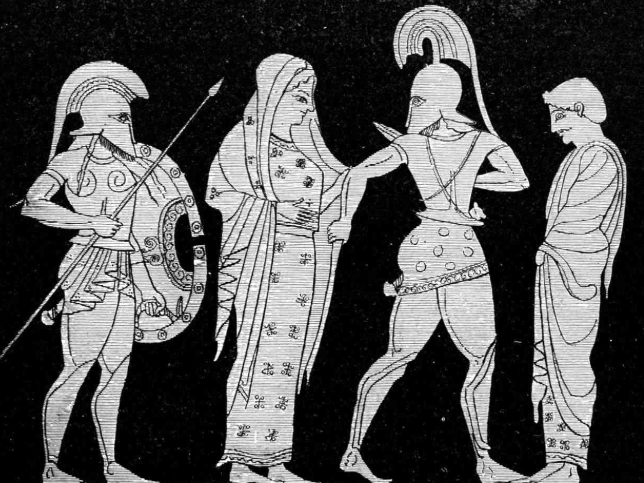In Homer’s epic poem The Iliad, Helen of Troy plays a crucial role as one of the central figures in the Trojan War. While her actions and presence are significant throughout the narrative, one specific moment often catches the attention of readers and scholars: Helen weaving a tapestry in Book 3. This act carries deep symbolic and thematic significance, providing insights into her character, the war, and the human condition as depicted in The Iliad.
This article will explore what is the significance of Helen weaving in The Iliad, shedding light on its symbolic meaning, its impact on the narrative, and its broader implications.
Helen’s Role in The Iliad
Before diving into the act of weaving, it’s essential to understand Helen’s role in The Iliad. Known as “the face that launched a thousand ships,” Helen is both the cause of the Trojan War and a complex character caught in its turmoil.
- The Catalyst of War: Helen’s abduction (or elopement) by Paris sparks the conflict between the Greeks and Trojans.
- A Symbol of Beauty and Conflict: Her beauty makes her a prize in the eyes of men, but it also burdens her with guilt and shame for the destruction caused by the war.
- A Reflection of Agency and Passivity: While she appears as a passive figure in some moments, acts like weaving suggest her agency and introspection.
The Act of Weaving in Ancient Greek Culture
Weaving held deep cultural and symbolic significance in ancient Greece.
- A Domestic Role: Women’s primary responsibilities in ancient Greece included managing the household and engaging in domestic crafts like weaving. This activity was seen as a reflection of a woman’s virtue and industriousness.
- 2. Symbolism of Fate: In Greek mythology, weaving often symbolizes the threads of fate. The Fates themselves are depicted as weavers who determine the course of human lives.
- A Tool for Expression: Weaving allowed women to tell stories or preserve memories through intricate designs, functioning as a medium for communication and self-expression.
Understanding these cultural elements helps contextualize the importance of Helen’s weaving in The Iliad.
Helen Weaving in Book 3
In Book 3 of The Iliad, Helen is found weaving a tapestry that depicts scenes of the Trojan War. This moment is rich in meaning and highlights several key aspects of the story and Helen’s character.
A Symbol of Reflection and Guilt
Helen’s choice to weave scenes of the war reflects her deep awareness of the conflict’s consequences. By immortalizing the battles in her tapestry, she confronts the destruction her involvement has caused.
- An Act of Remorse: Weaving the war may signify Helen’s guilt over her perceived role in the war’s devastation.
- A Reflection of Suffering: The tapestry illustrates her understanding of the pain and loss experienced by both sides.
Weaving as a Metaphor for Storytelling
In a way, Helen’s weaving parallels Homer’s role as a storyteller. Just as Homer weaves together the narrative of The Iliad, Helen uses her tapestry to construct a visual representation of events.
- Preserving History: The act symbolizes the recording of history for future generations.
- A Silent Voice: Through weaving, Helen communicates her perspective, which is otherwise overshadowed by the voices of men in the epic.
The Broader Symbolism of Helen’s Weaving
Helen’s weaving transcends her personal story and reflects broader themes within The Iliad.
The Fragility of Human Life
The threads of Helen’s tapestry symbolize the fragility and interconnectedness of human lives. The war, with all its chaos and destruction, is depicted as a delicate web, easily unraveled by conflict.
The Role of Women in War
While men fight on the battlefield, women like Helen bear the emotional burden of war. Her weaving serves as a subtle critique of the traditional roles assigned to women, highlighting their capacity for introspection and creativity.
The Inevitability of Fate
By weaving scenes of the war, Helen acknowledges the inevitability of fate. The war’s outcome is already determined, much like the threads in her tapestry. This mirrors the larger theme of predestined events that runs throughout The Iliad.
How Helen’s Weaving Impacts the Narrative?
Helen’s weaving serves as a narrative tool that deepens the reader’s understanding of her character and the epic’s themes.
- Humanizing Helen: Often viewed as a symbol or object, this moment reveals her as a deeply reflective and emotional individual.
- Foreshadowing Destruction: The scenes she weaves foreshadow the tragedy that will unfold, emphasizing the epic’s somber tone.
- Creating Contrast: Her quiet, introspective activity contrasts sharply with the chaos and violence of the battlefield, underscoring the duality of war.
The Modern Relevance of Helen’s Weaving
Even today, Helen’s weaving resonates with audiences, offering timeless lessons about storytelling, responsibility, and the human experience.
- The Power of Art: Helen’s tapestry reminds us of the enduring power of art to capture and preserve history.
- The Complexity of Blame: Her act challenges simplistic notions of guilt, encouraging readers to empathize with her struggles.
- Women’s Voices: Helen’s weaving highlights the importance of acknowledging women’s perspectives, even in male-dominated narratives.
Conclusion
The act of Helen weaving in The Iliad is far more than a simple depiction of domestic activity. It serves as a powerful symbol of reflection, storytelling, and the human condition. Through this moment, Homer provides a deeper insight into Helen’s character, the consequences of war, and the intricate web of fate that binds all the epic’s characters.
By understanding what is the significance of Helen weaving in The Iliad, readers can appreciate the richness of Homer’s narrative and the timeless themes that continue to resonate today.
FAQs
Why does Helen weave scenes of the Trojan War?
Helen weaves scenes of the Trojan War as a way to reflect on her role in the conflict and immortalize the events. This act symbolizes her guilt, introspection, and awareness of the war’s impact.
What does weaving symbolize in ancient Greek culture?
In ancient Greek culture, weaving symbolizes domestic virtue, storytelling, and the threads of fate. It was often used as a metaphor for life’s interconnectedness and fragility.
How does Helen’s weaving impact the story of The Iliad?
Helen’s weaving humanizes her character, foreshadows the epic’s tragic events, and provides a contrast to the violence of the battlefield.
Is Helen’s weaving a form of storytelling?
Yes, Helen’s weaving can be seen as a form of storytelling. Through her tapestry, she visually narrates the events of the Trojan War, offering her perspective on the conflict.
What lessons can modern readers learn from Helen’s weaving?
Modern readers can learn about the power of art, the complexity of guilt, and the importance of acknowledging diverse perspectives, especially women’s voices, in storytelling.







